Reservoir Characterisation of High-Pressure, High-Temperature Zone of Malay Basin Using Seismic Inversion and Artificial Neural Network Approach
Abstract
:1. Introduction
2. Geological Background
3. Dataset and Methods
3.1. Dataset
3.1.1. Well Data
3.1.2. Seismic Data
- Navigation merge;
- Designature;
- Geometrical spreading amplitude compensation;
- Swell noise attenuation;
- Q compensation;
- Predictive deconvolution;
- Radon demultiplex;
- 3D interpolation and regularisation;
- Velocity analysis;
- Pre-stack time migration;
- Sort to angle gathers.
3.2. Methods
3.2.1. Rock Physics Study
3.2.2. Pre-Stack Inversion
3.2.3. SQp and SQs Attributes
3.2.4. Artificial Neural Network (ANN)
4. Field Application and Results
4.1. Rock Physics Study
4.2. Pre-Stack Inversion
4.3. SQp and SQs Attributes
4.4. Artificial Neural Network (ANN)
5. Conclusions
Author Contributions
Funding
Institutional Review Board Statement
Informed Consent Statement
Acknowledgments
Conflicts of Interest
References
- Journel, A.G. Geology and Reservoir Geology. Stochastic Modeling and Geostatistics; Yarus, J.M., Chambers, R.L., Eds.; AAPG Computer Applications in Geology: Tulsa, OK, USA, 1995; pp. 19–20. [Google Scholar]
- Al-hasani, A.; Hakimi, M.H.; Saaid, I.M.; Salim, A.M.A.; Mahat, S.Q.A.; Ahmed, A.A.; Umar, A.A.B. Reservoir characteristics of the Kuhlan sandstones from Habban oilfield in the Sabatayn Basin, Yemen and their relevance to reservoir rock quality and petroleum accumulation. J. Afr. Earth Sci. 2018, 145, 131–147. [Google Scholar] [CrossRef]
- Das, B.; Chatterjee, R. Well log data analysis for lithology and fluid identification in Krishna-Godavari Basin, India. Arab. J. Geosci. 2018, 11, 231. [Google Scholar] [CrossRef]
- Schultz, P.S.; Ronen, S.; Hattori, M.; Corbett, C. Seismic-guided estimation of log properties Part 1: A data-driven interpretation methodology. Lead. Edge 1994, 13, 305–310. [Google Scholar] [CrossRef]
- Saikia, P.; Baruah, R.D.; Singh, S.K.; Chaudhuri, P.K. Artificial Neural Networks in the domain of reservoir characterization: A review from shallow to deep models. Comput. Geosci. 2020, 135, 104357. [Google Scholar] [CrossRef]
- Babasafari, A.A.; Ghosh, D.P.; Salim, A.M.A.; Kordi, M. Integrating petroelastic modeling, stochastic seismic inversion, and Bayesian probability classification to reduce uncertainty of hydrocarbon prediction: Example from Malay Basin. Interpretation 2020, 8, SM65–SM82. [Google Scholar] [CrossRef]
- Gogoi, T.; Chatterjee, R. Estimation of petrophysical parameters using seismic inversion and neural network modeling in Upper Assam basin, India. Geosci. Front. 2018, 10, 1113–1124. [Google Scholar] [CrossRef]
- Smithson, T. The Defining Series: HPHT Wells; Oilfield Review; Schlumberger: Houston, TX, USA, 2016. [Google Scholar]
- Shadravan, A.; Amani, M. HPHT 101—What every engineer or geoscientist should know about high pressure high temperature wells. In Proceedings of the SPE Kuwait International Petroleum Conference and Exhibition, Kuwait City, Kuwait, 10–12 December 2012; Volume 2, pp. 917–943. [Google Scholar] [CrossRef]
- He, W.; Hao, J.; Yang, J.; Guan, X.; Dai, R.; Li, Y. Application of pre-stack simultaneous inversion to predict gas-bearing dolomite reservoir: A case study from Sichuan Basin, China. Carbonates Evaporites 2019, 34, 1191–1201. [Google Scholar] [CrossRef]
- Francis, A. A Simple Guide to Seismic Inversion. GeoExPro 2013, 10, 46–50. [Google Scholar]
- Verma, A.K.; Cheadle, B.A.; Routray, A.; Mohanty, W.K.; Mansinha, L. Porosity and Permeability estimation using neural network approach from well log data. In Proceedings of the SPE Annual Technical Conference and Exhibition, San Antonio, TX, USA, 8–10 October 2012. [Google Scholar]
- Madon, M. Petroleum Geology and Resources of Malaysia; Petronas: Kuala Lumpur, Malaysia, 1999. [Google Scholar]
- Uttarathiyang, T.; Pigott, J.D. New Unexplored Thailand Basin Frontier: North Malay Basin Post Rift Oligocene Deltas. In Proceedings of the International Symposia on Geoscience and Environments of Asian Terranes (GREAT 2008), 4th IGCP 516 and 5th APSEG, Bangkok, Thailand, 24–26 November 2008; pp. 370–373. [Google Scholar]
- Kumar, M.; Dasgupta, R.; Singha, D.K.; Singh, N.P. Petrophysical evaluation of well log data and rock physics modeling for characterization of Eocene reservoir in Chandmari oil field of Assam-Arakan basin, India. J. Pet. Explor. Prod. Technol. 2018, 8, 323–340. [Google Scholar] [CrossRef] [Green Version]
- Goodway, B.; Chen, T.; Downtown, J. Improved AVO fluid detection and lithology discrimination using Lame petrophysical parameters. In Proceedings of the 67th Annual international Meeting, SEG, Expanded Abstracts, Dallas, TX, USA, 2–7 November 1997; pp. 183–186. [Google Scholar]
- Perez, M.A.; Tonn, R. Reservoir Modelling and Interpretation with Lamé’s Parameters: A Grand Banks Case Study; EnCana Corporation: Calgary, AB, Canada, 2003; pp. 1–11. [Google Scholar]
- Hermana, M.; Ngui, J.Q.; Sum, C.W.; Ghosh, D.P. Feasibility Study of SQp and SQs Attributes Application for Facies Classification. Geosciences 2018, 8, 10. [Google Scholar] [CrossRef] [Green Version]
- Varatharajoo, S.; Hermana, M. Feasibility Study of SQs attribute application for porosity estimation in Carbonate reservoir, Central Luconia. Platf. J. Sci. Technol. 2019, 2, 11–18. [Google Scholar]
- Hermana, M.; Lubis, L.A. A Novel Method in Hydrocarbon and Reservoir Properties Prediction Based on Elastic Properties. J. Earth Sci. Technol. 2020, 1, 38–43. [Google Scholar]
- Ridwan, T.K.; Hermana, M.; Lubis, L.A.; Riyadi, Z.A. New avo attributes and their applications for facies and hydrocarbon prediction: A case study from the northern malay basin. Appl. Sci. 2020, 10, 7786. [Google Scholar] [CrossRef]
- Hermana, M.; Ghosh, D.P.; Sum, C.W. Discriminating lithology and pore fill in hydrocarbon prediction from seismic elastic inversion using absorption attributes. Lead. Edge 2017, 36, 902–909. [Google Scholar] [CrossRef]
- Lavergne, M.; Willm, C. Inversion of seismogram and pseudo velocity logs. Geophys. Prospect. 1977, 25, 231–250. [Google Scholar] [CrossRef]
- Lindseth, R.O. Synthetic sonic logs-a process for stratigraphic interpretation. Geophysics 1979, 44, 3–26. [Google Scholar] [CrossRef]
- Hampson, D.P.; Schuelke, J.S.; Quirein, J.A. Use of multiattribute transforms to predict log properties from seismic data. Geophysics 2001, 66, 220–236. [Google Scholar] [CrossRef]
- Hermana, M.; Harith, Z.Z.T.; Sum, C.W.; Ghosh, D.P. The attribute for hydrocarbon prediction based on attenuation. IOP Conf. Ser. Earth Environ. Sci. 2014, 19, 12005. [Google Scholar] [CrossRef] [Green Version]
- Hermana, M.; Ghosh, D.P. Optimizing the Lithology and Pore Fluid Separation Using Attenuation Attributes. In Proceedings of the Offshore Technology Conference Asia (OTC) Exhibition 2016, Kuala Lumpur, Malaysia, 22–25 March 2016. [Google Scholar]
- Powell, M.J.D. Radial Basis Functions for Multivariable Interpolation: A Review; Algorithms for Approximation; Mason, J.C., Cox, M.G., Eds.; Carendon Press: Oxford, UK, 1987; pp. 143–167. [Google Scholar]
- Schultz, P.S.; Ronen, S.; Hattori, M.; Corbett, C. Seismic-guided estimation of log properties Part 3: A controleed study. Lead. Edge 1994, 13, 770–776. [Google Scholar] [CrossRef]
- Russell, B.H.; Hampson, D.P.; Lines, L.R. Application of the radial basis function neural network to the prediction of log properties from seismic attributes—A channel sand case study. Explor. Geophys. 2003, 34, 454–457. [Google Scholar] [CrossRef]
- Tavasoli, M.; Shooredeli, M.A.; Nekoui, M.A.; Najm, M.F. Petroleum reservoir properties estimation using neural networks. In Proceedings of the 2015 4th Iranian Joint Congress on Fuzzy and Intelligent Systems (CFIS), Zahedan, Iran, 9–11 September 2015; pp. 1–4. [Google Scholar] [CrossRef]
- Hermana, M.; Lubis, L.A.; Ghosh, D.P.; Sum, C.W. New rock physics template for better hydrocarbon prediction. In Proceedings of the Offshore Technology Conference Asia (OTC) Exhibition 2016, Kuala Lumpur, Malaysia, 22–25 March 2016; pp. 2900–2905. [Google Scholar] [CrossRef]

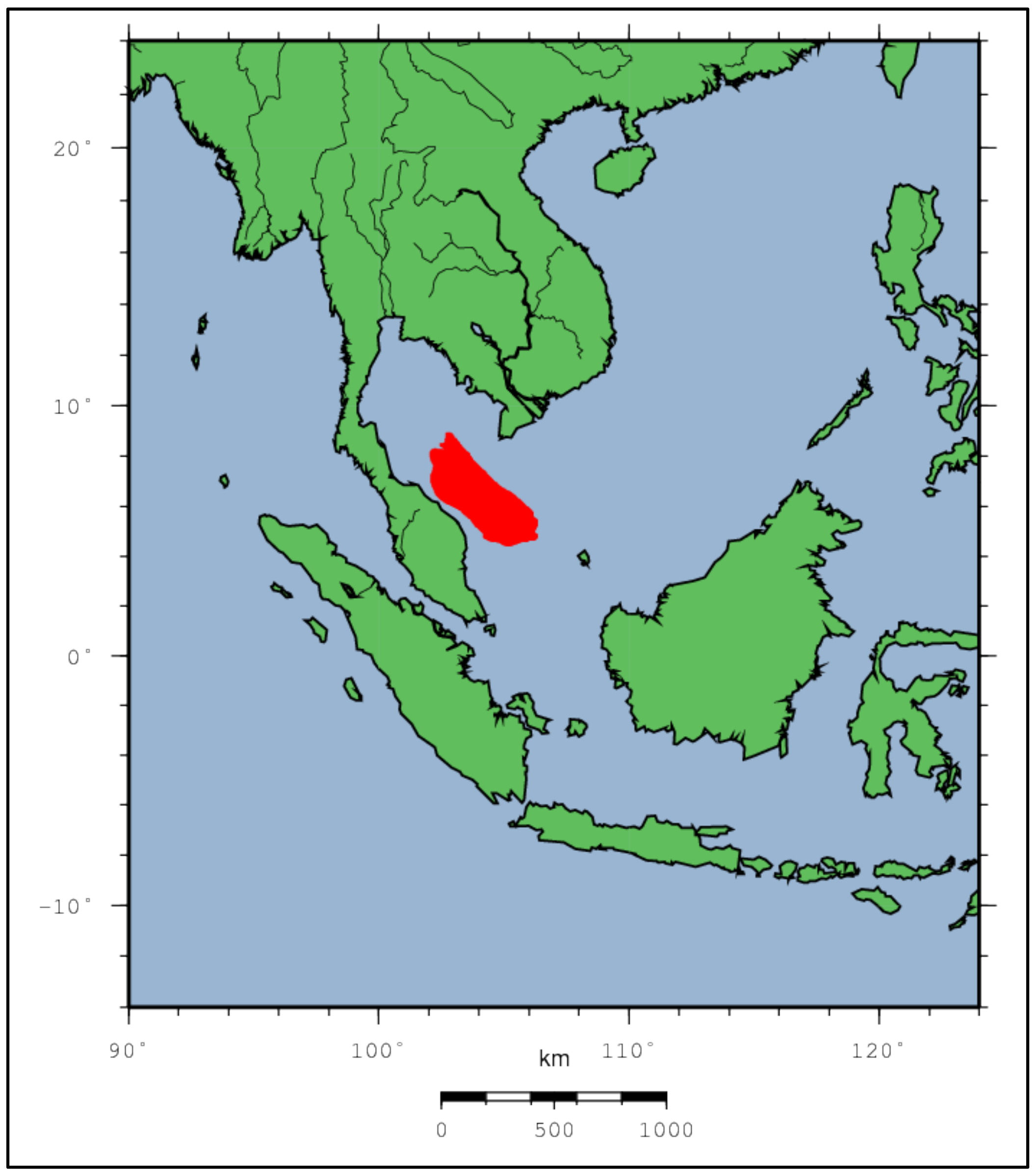


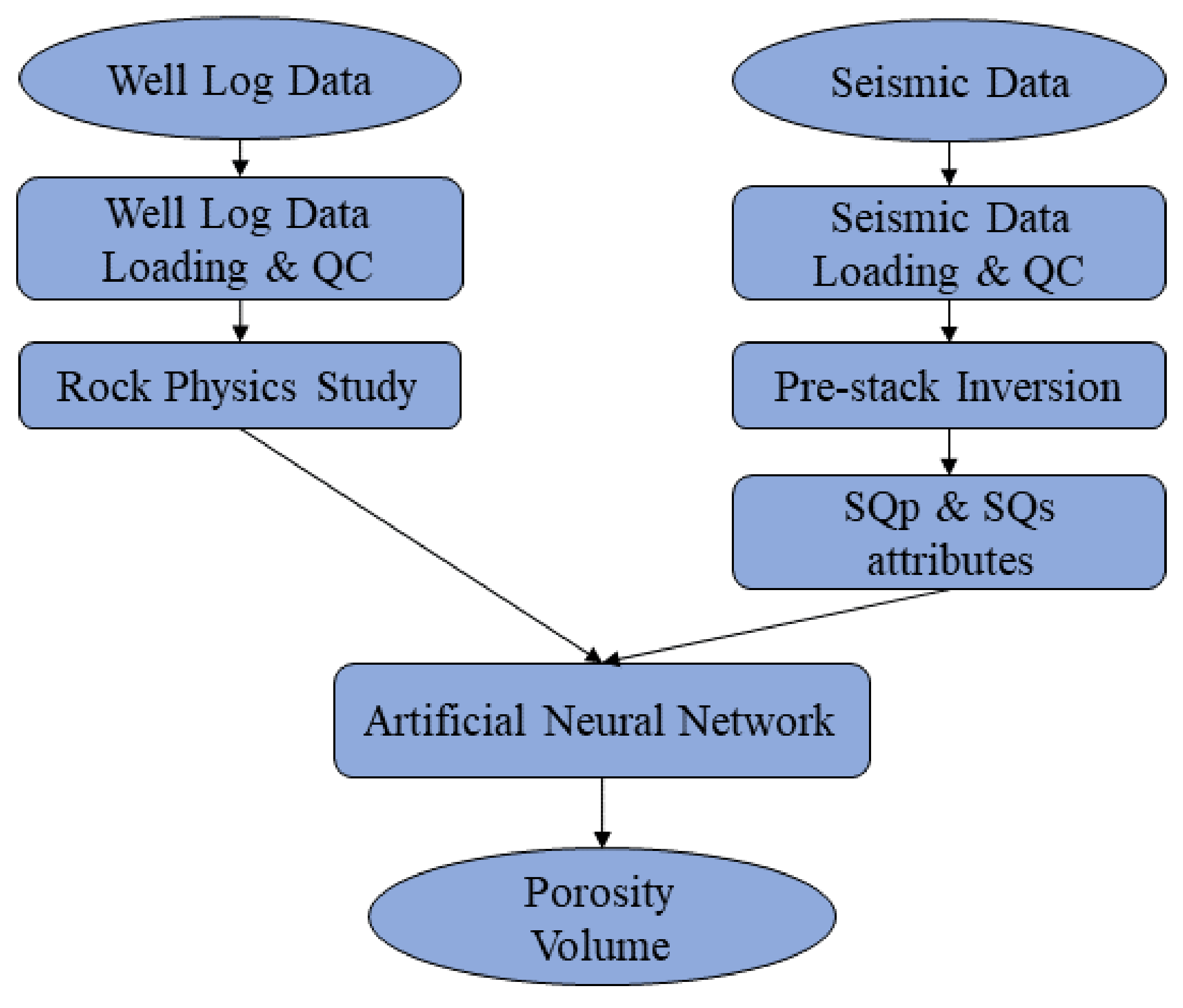
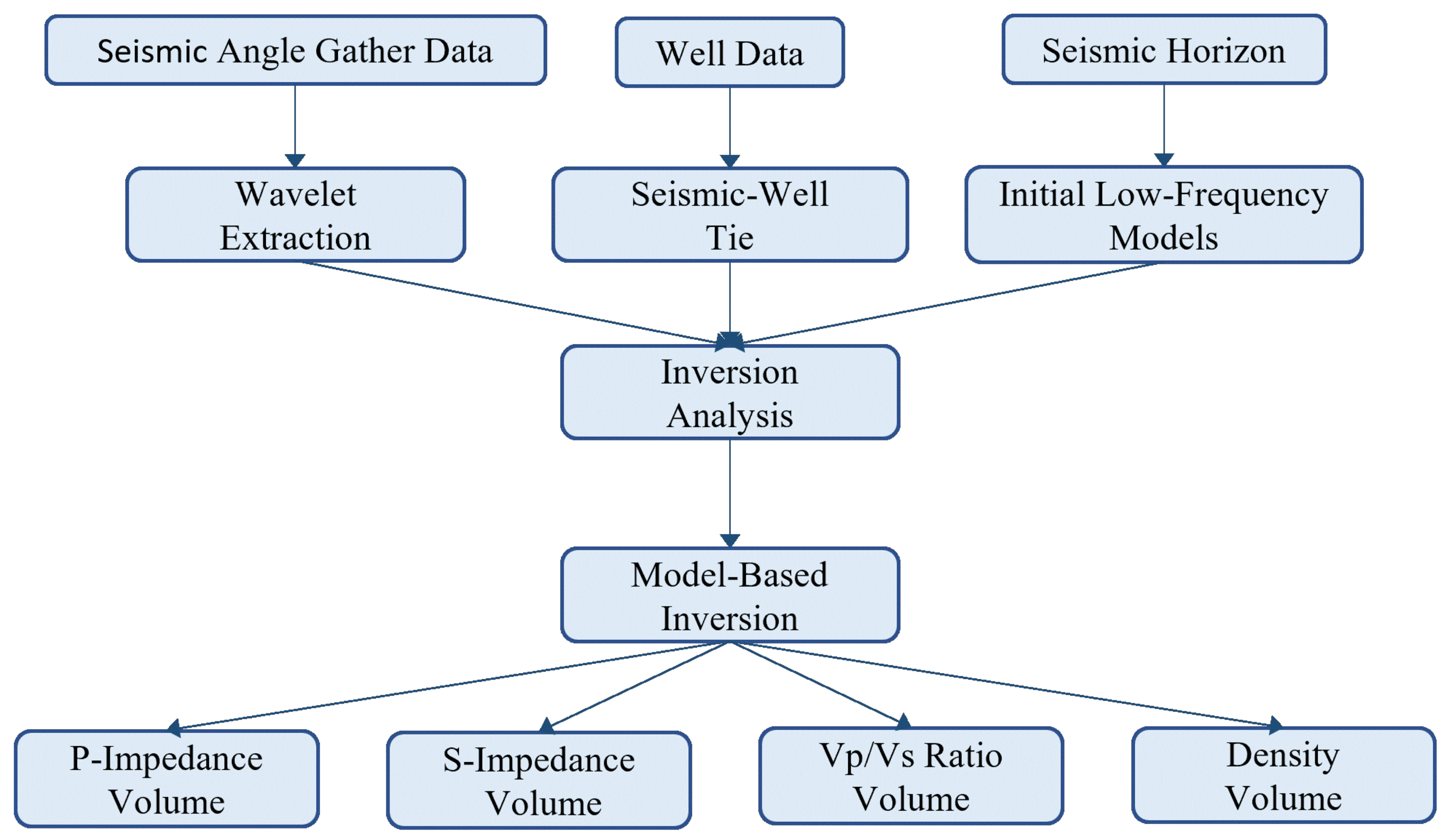
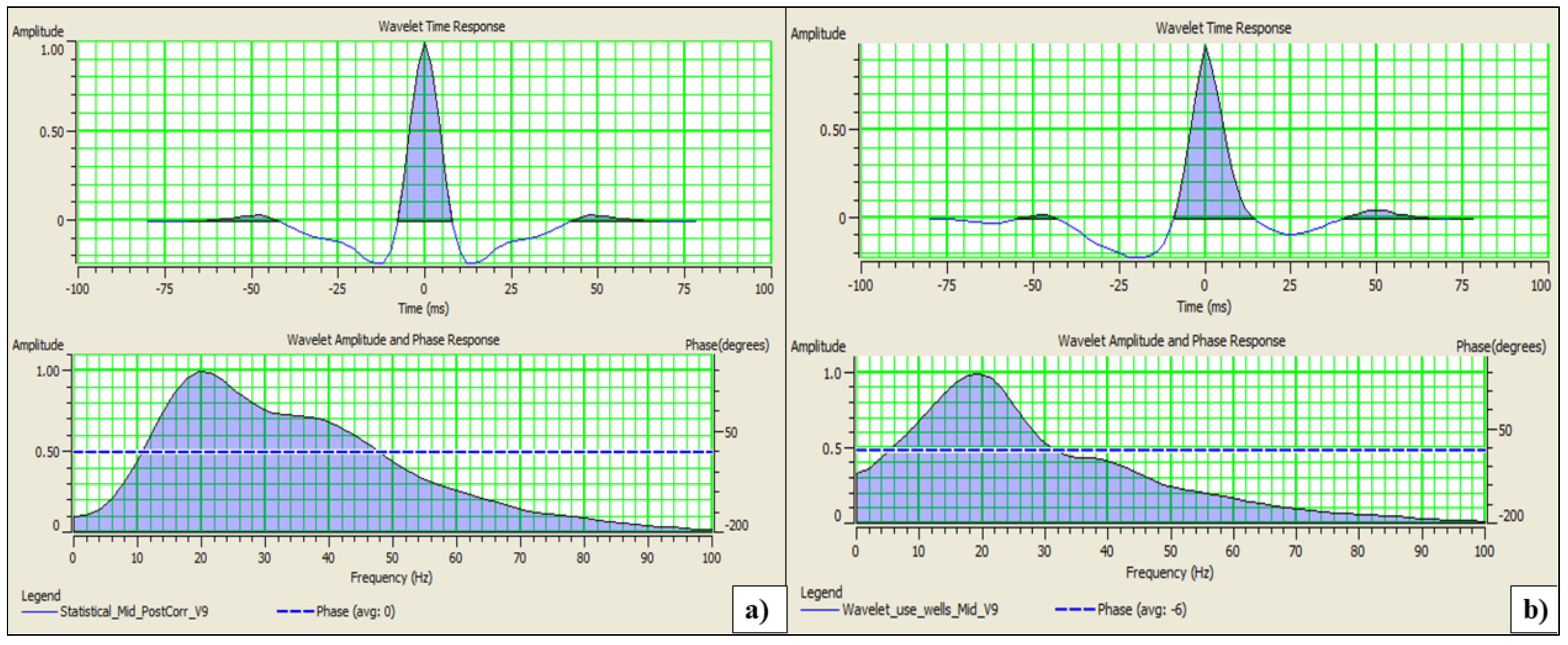
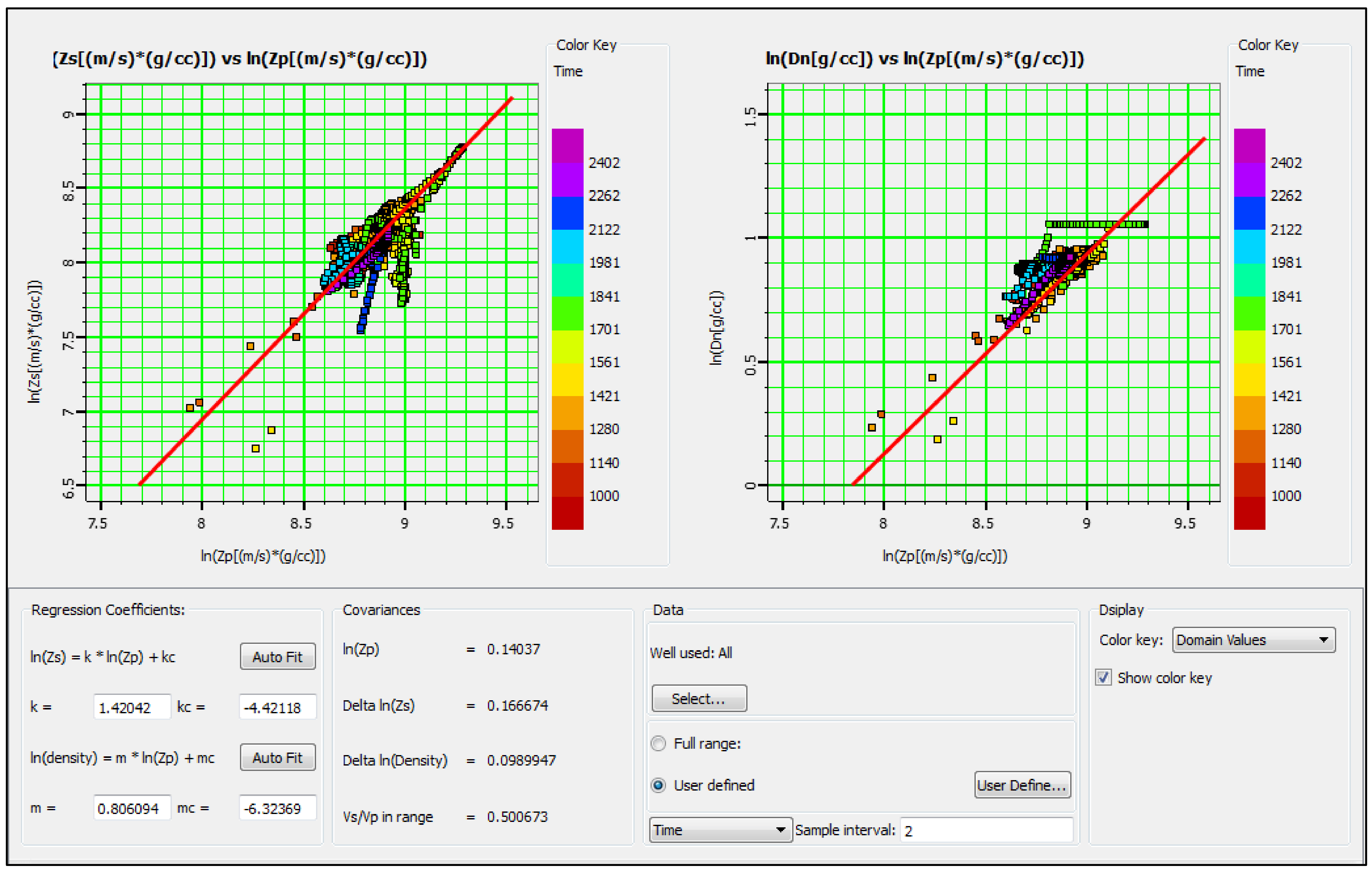
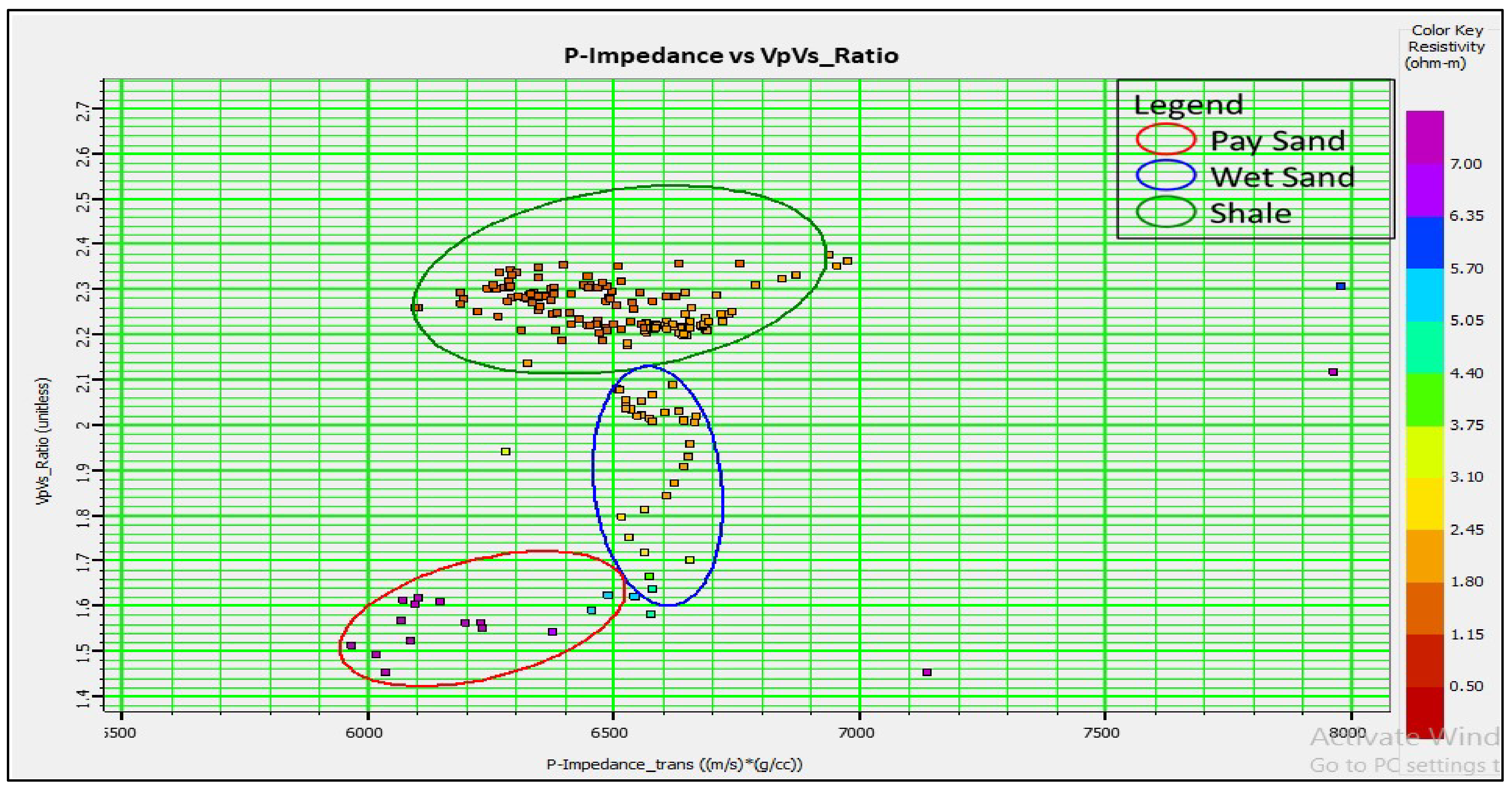

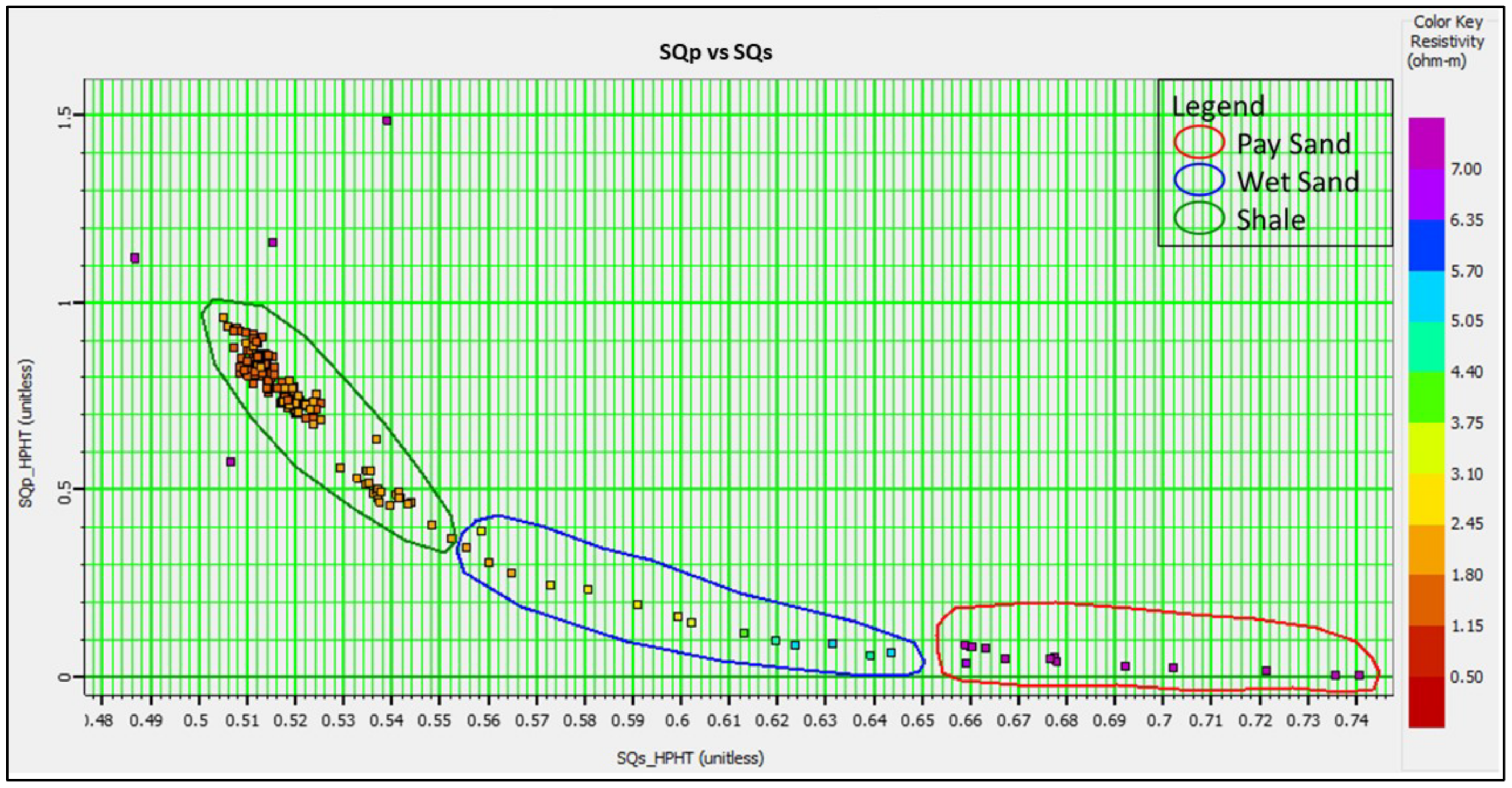
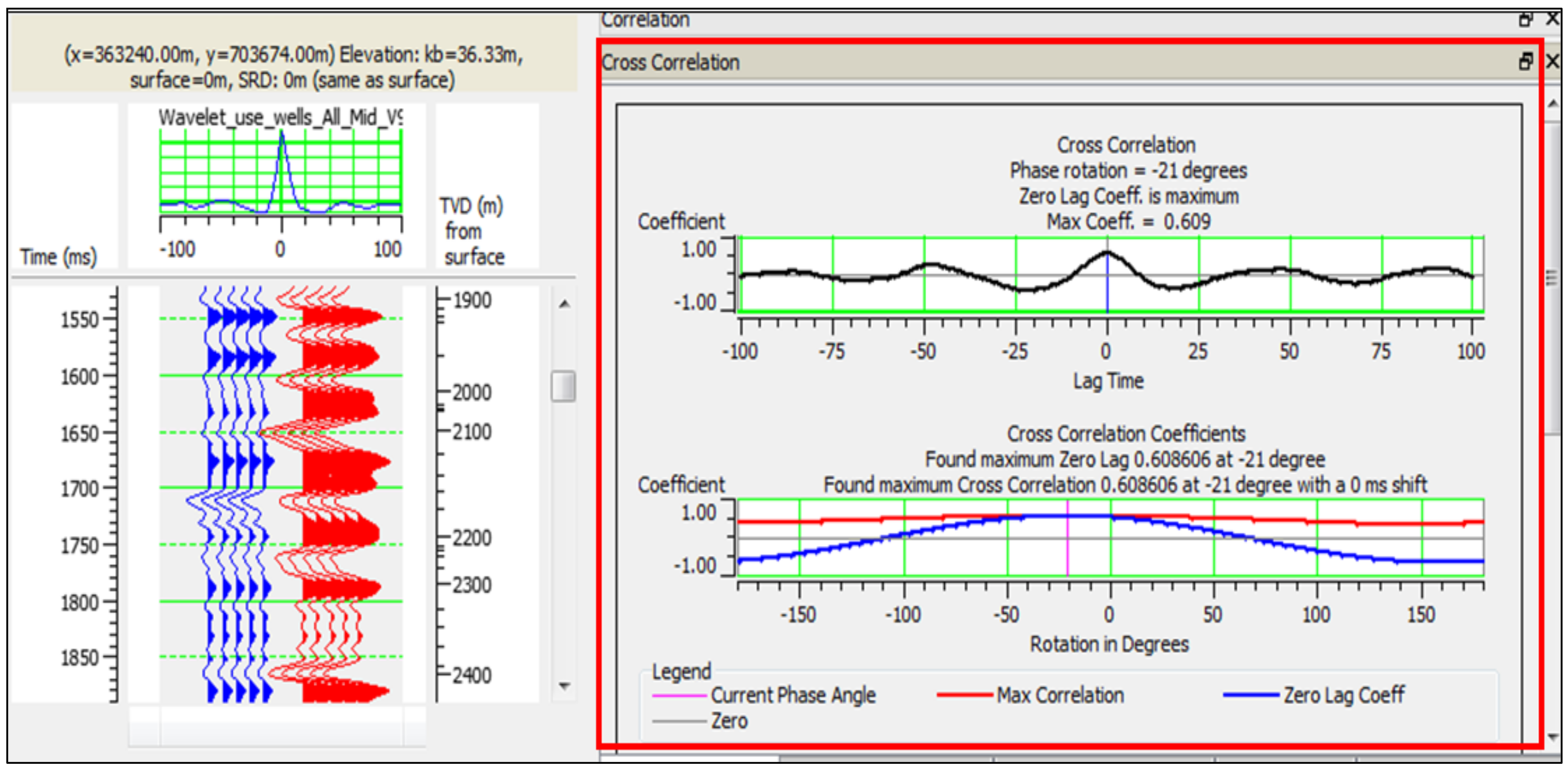

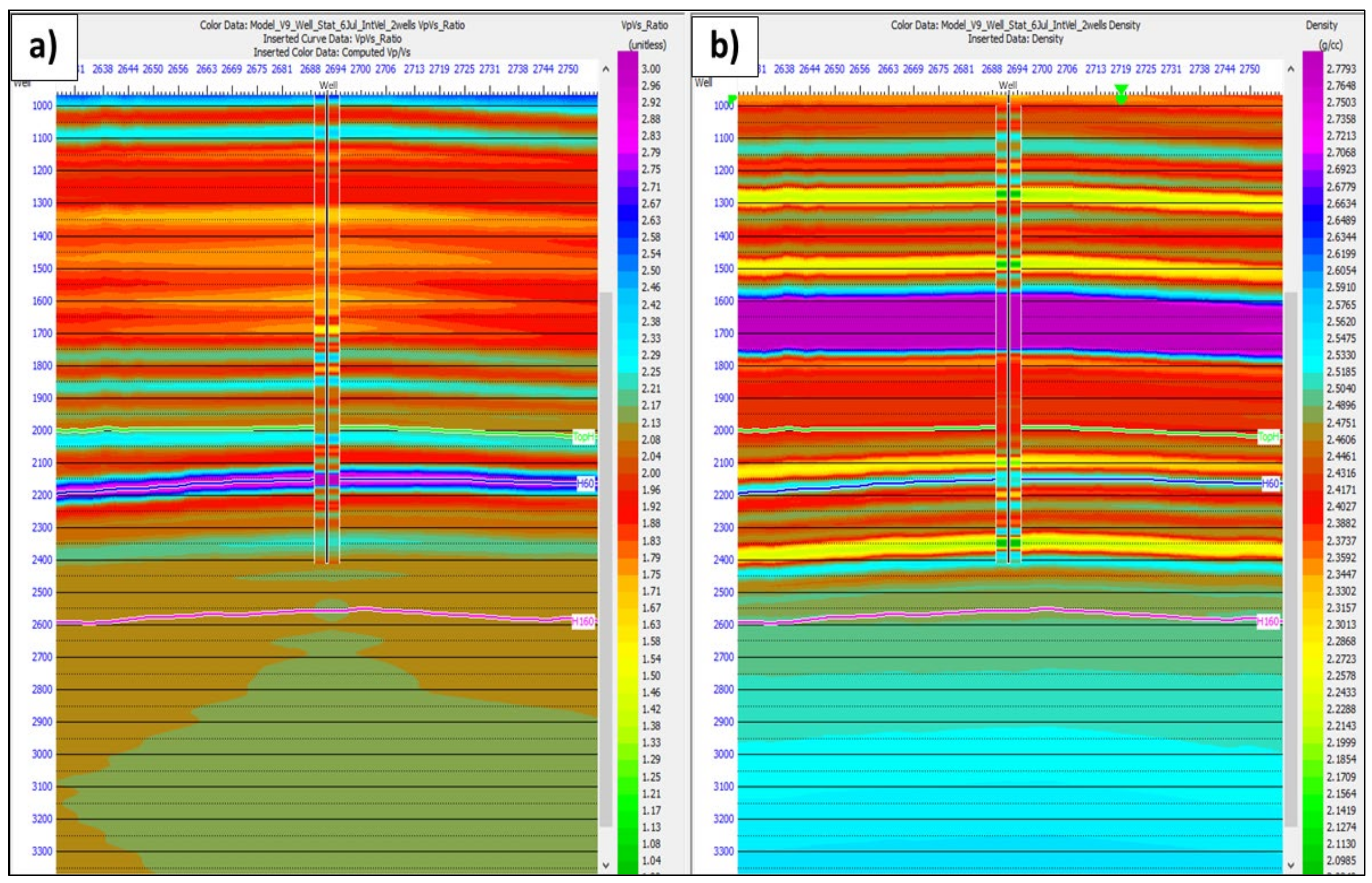
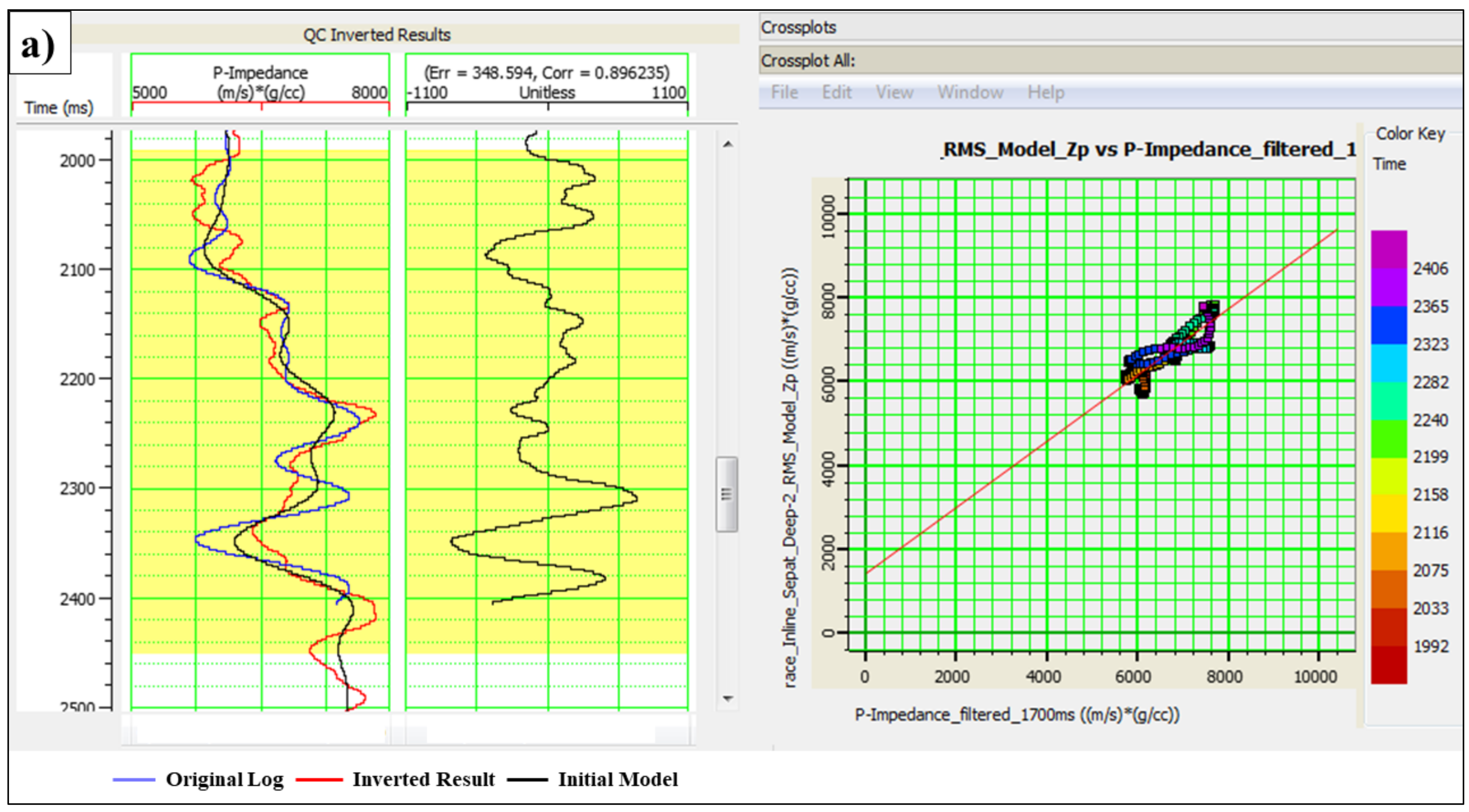
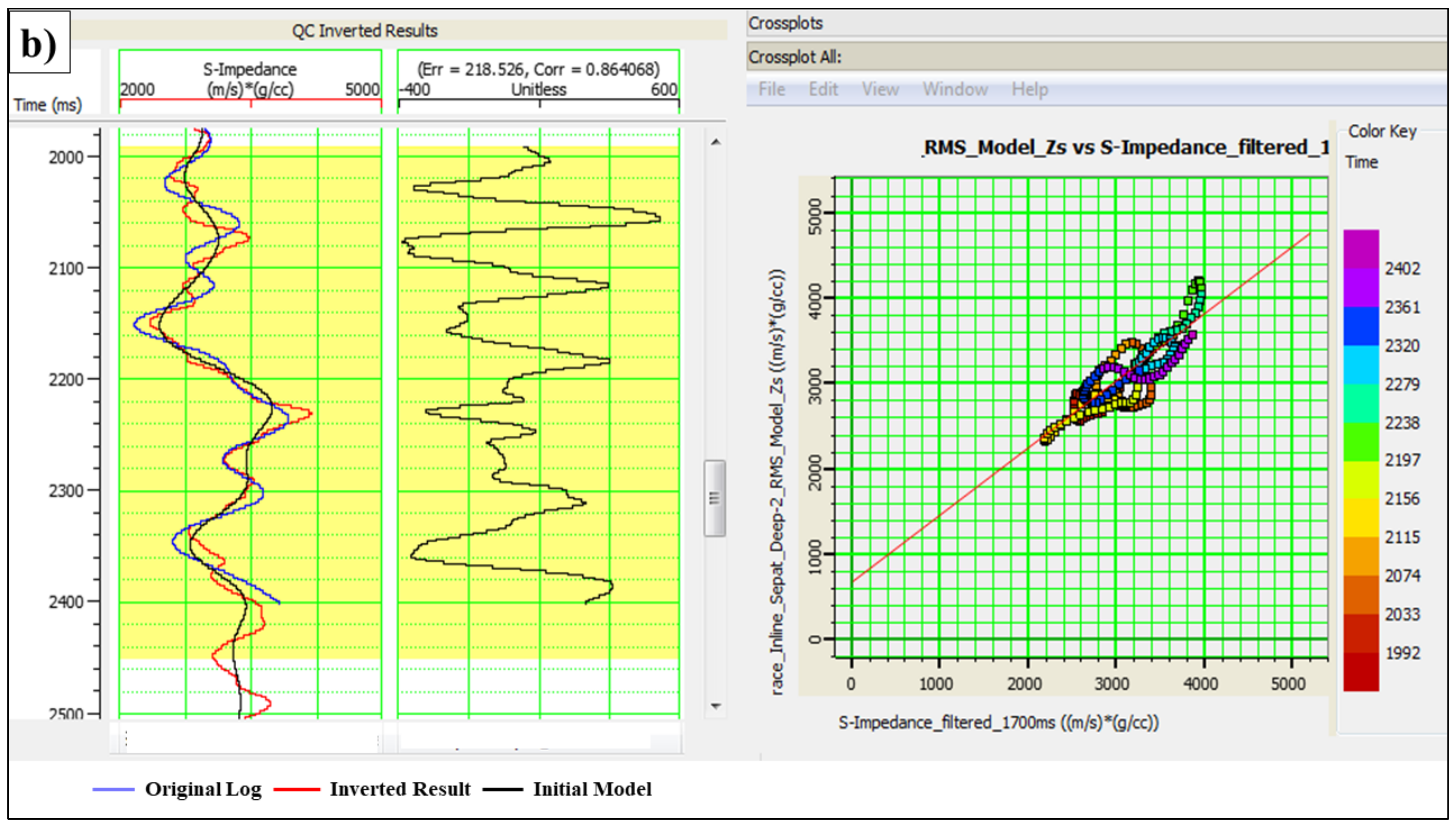
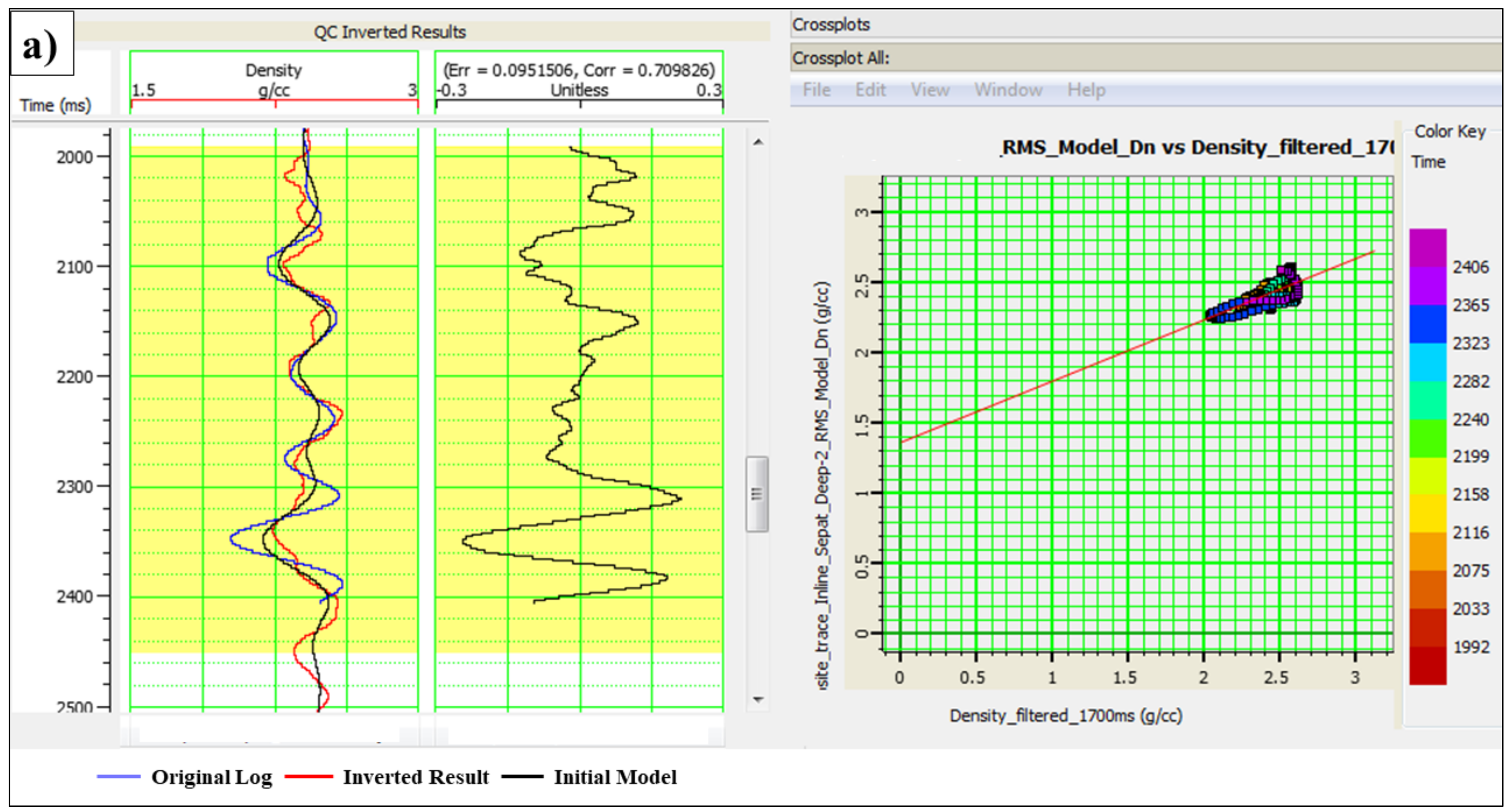
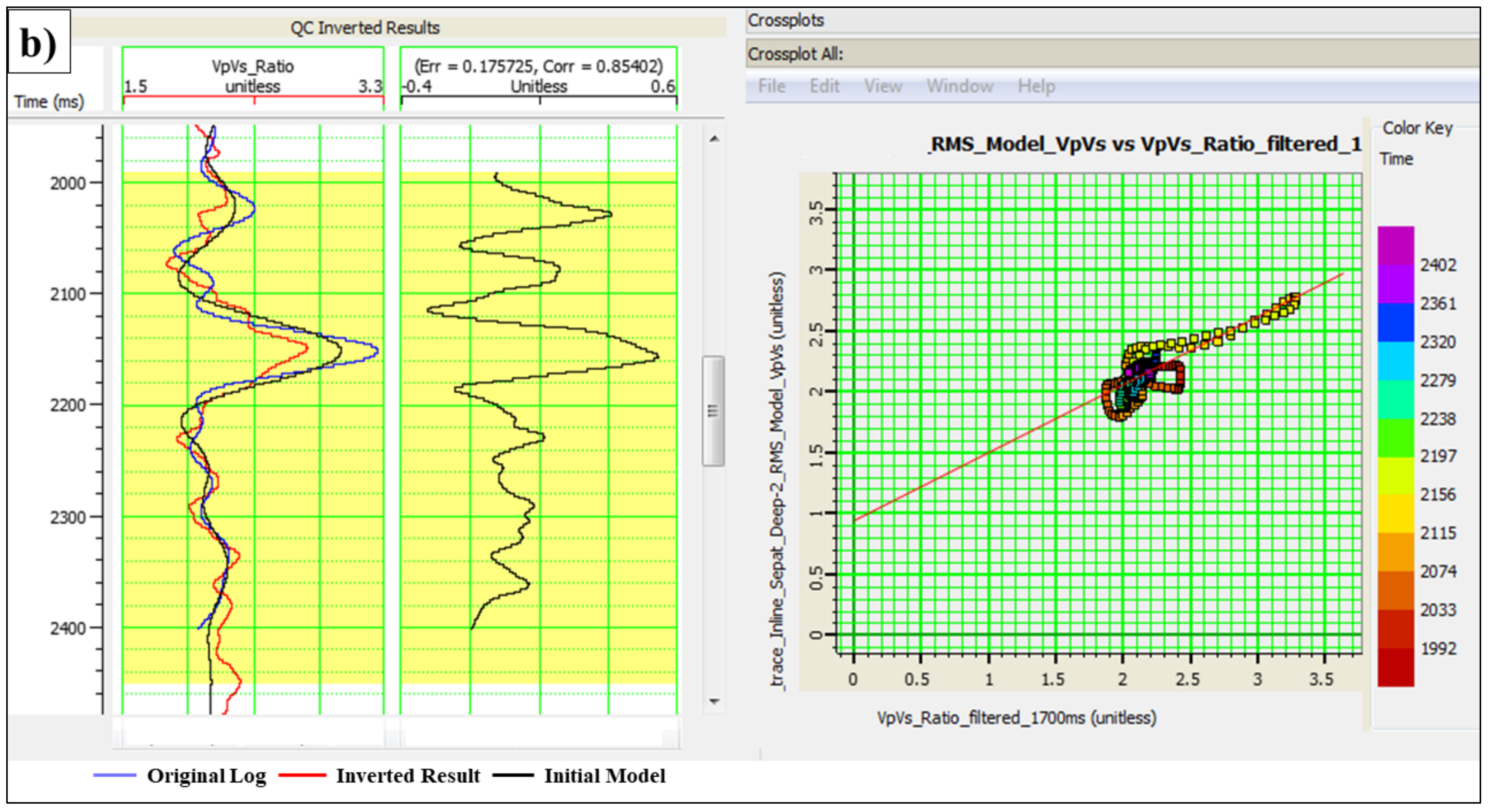
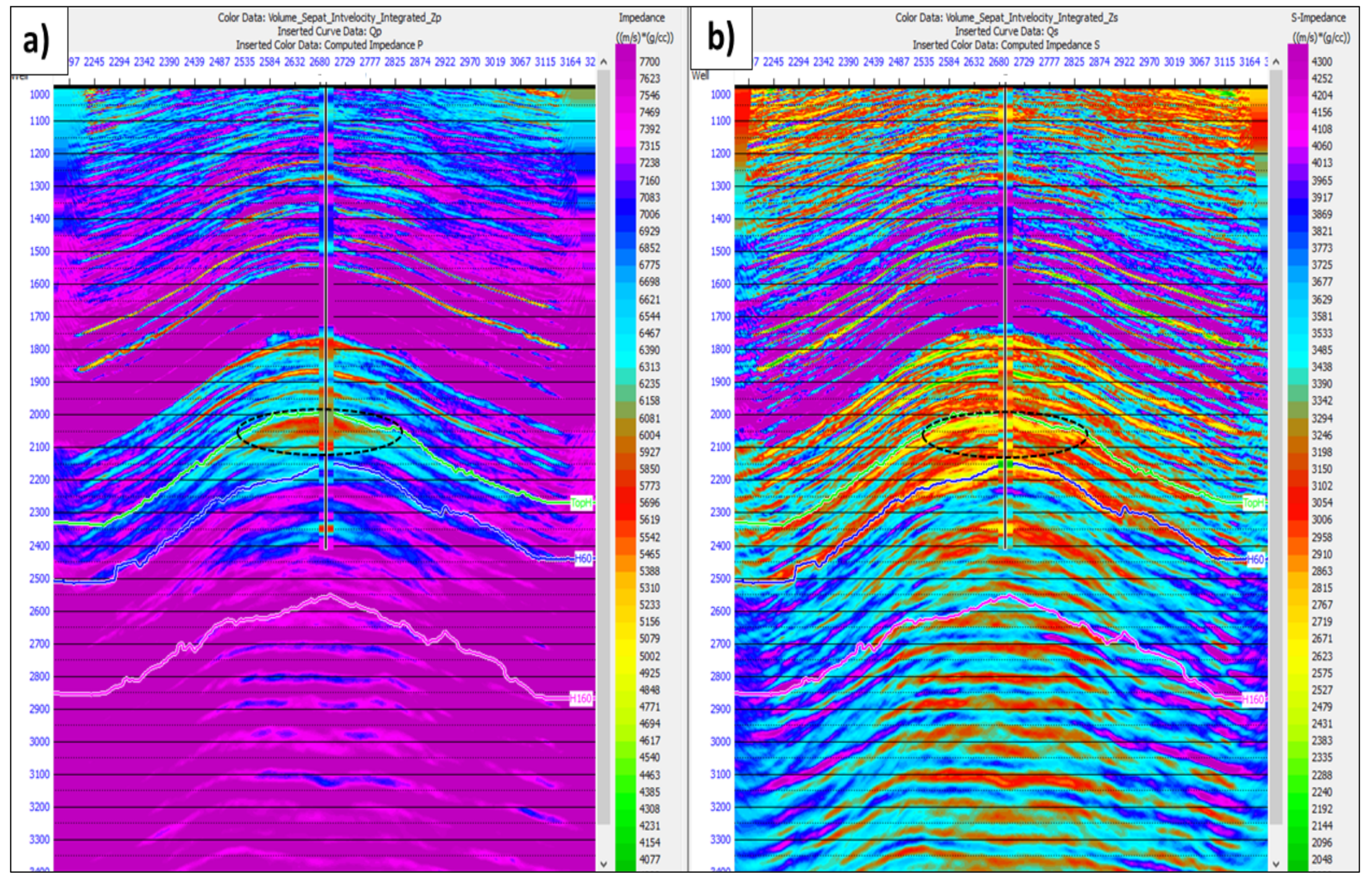
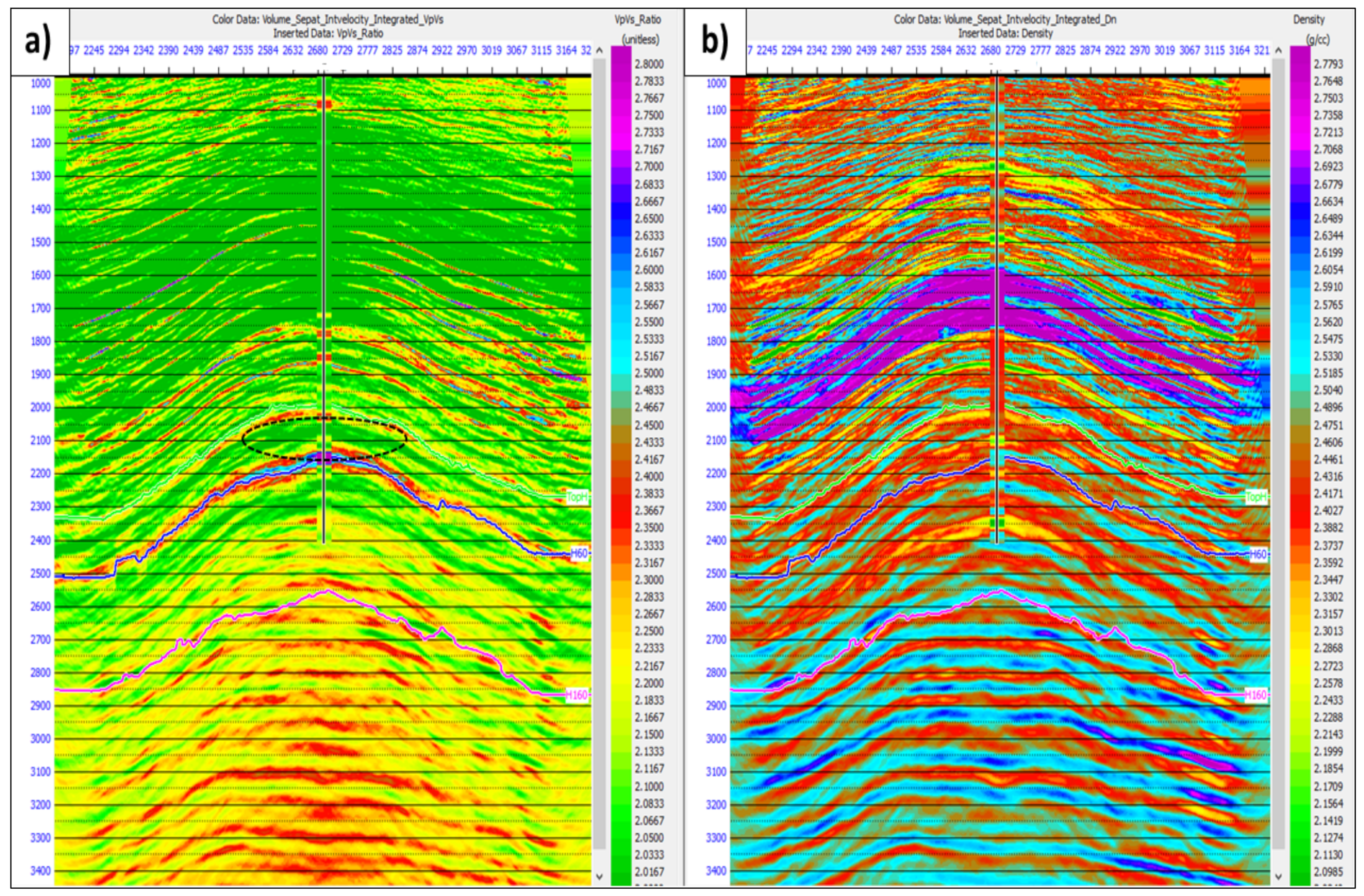


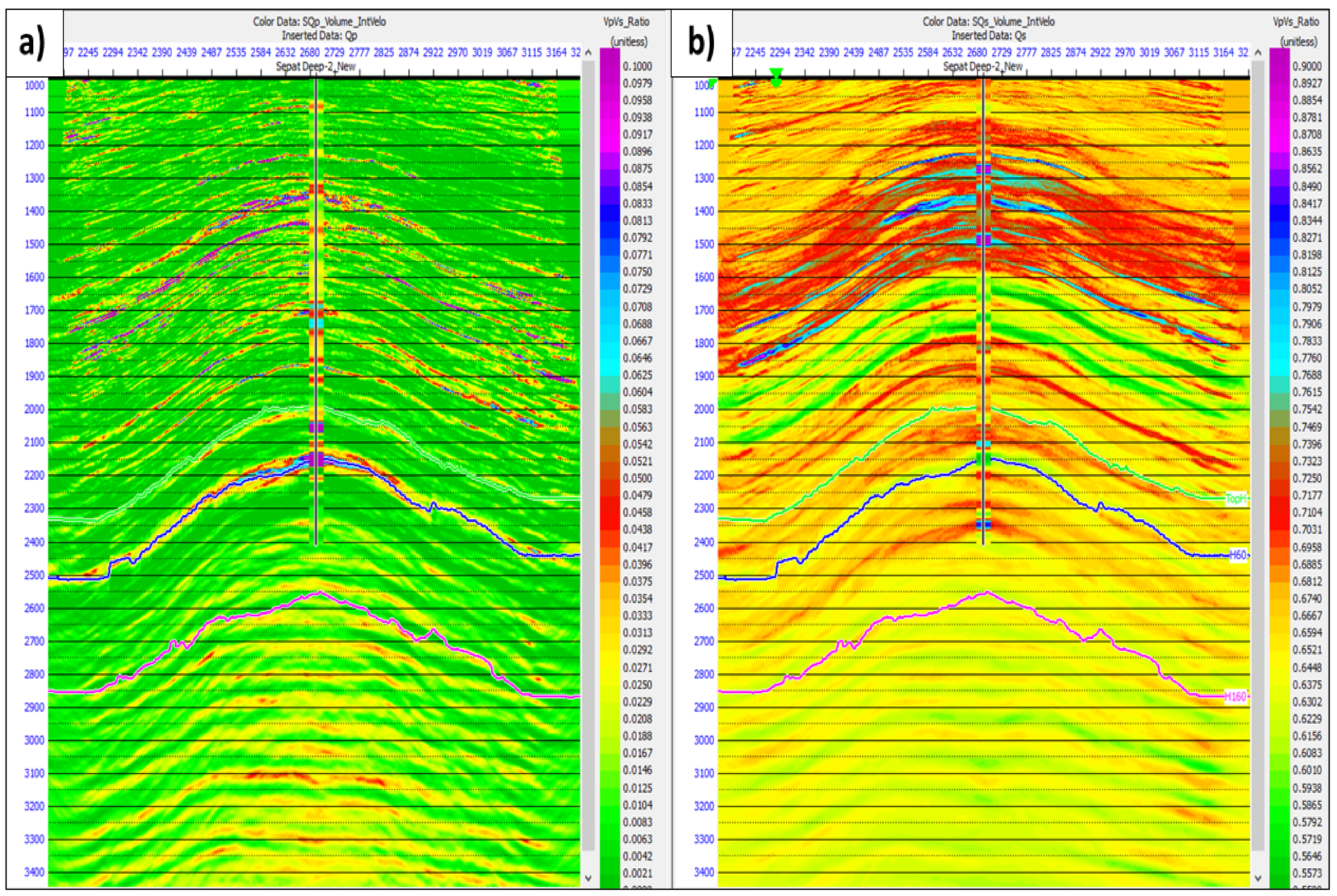
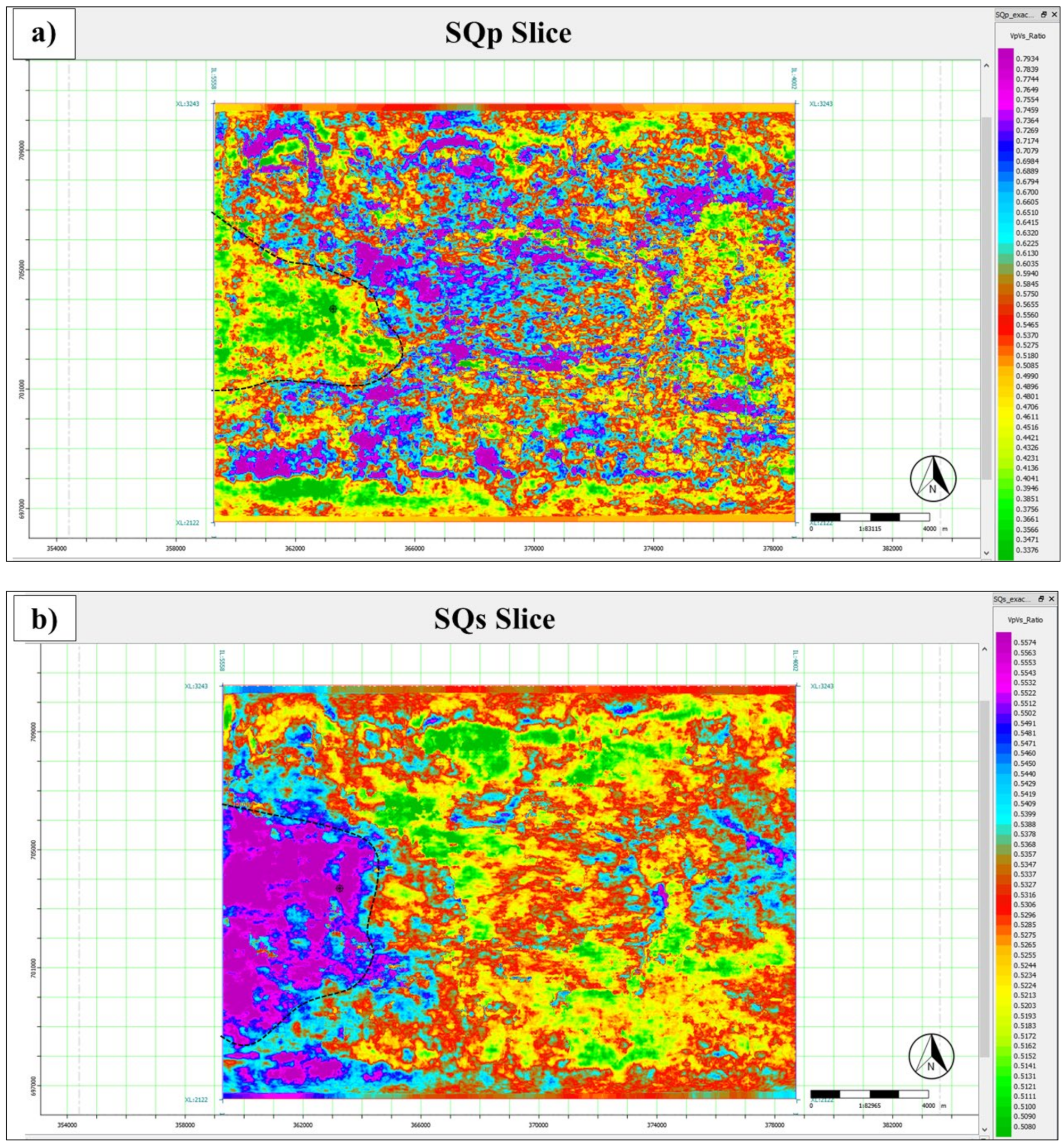
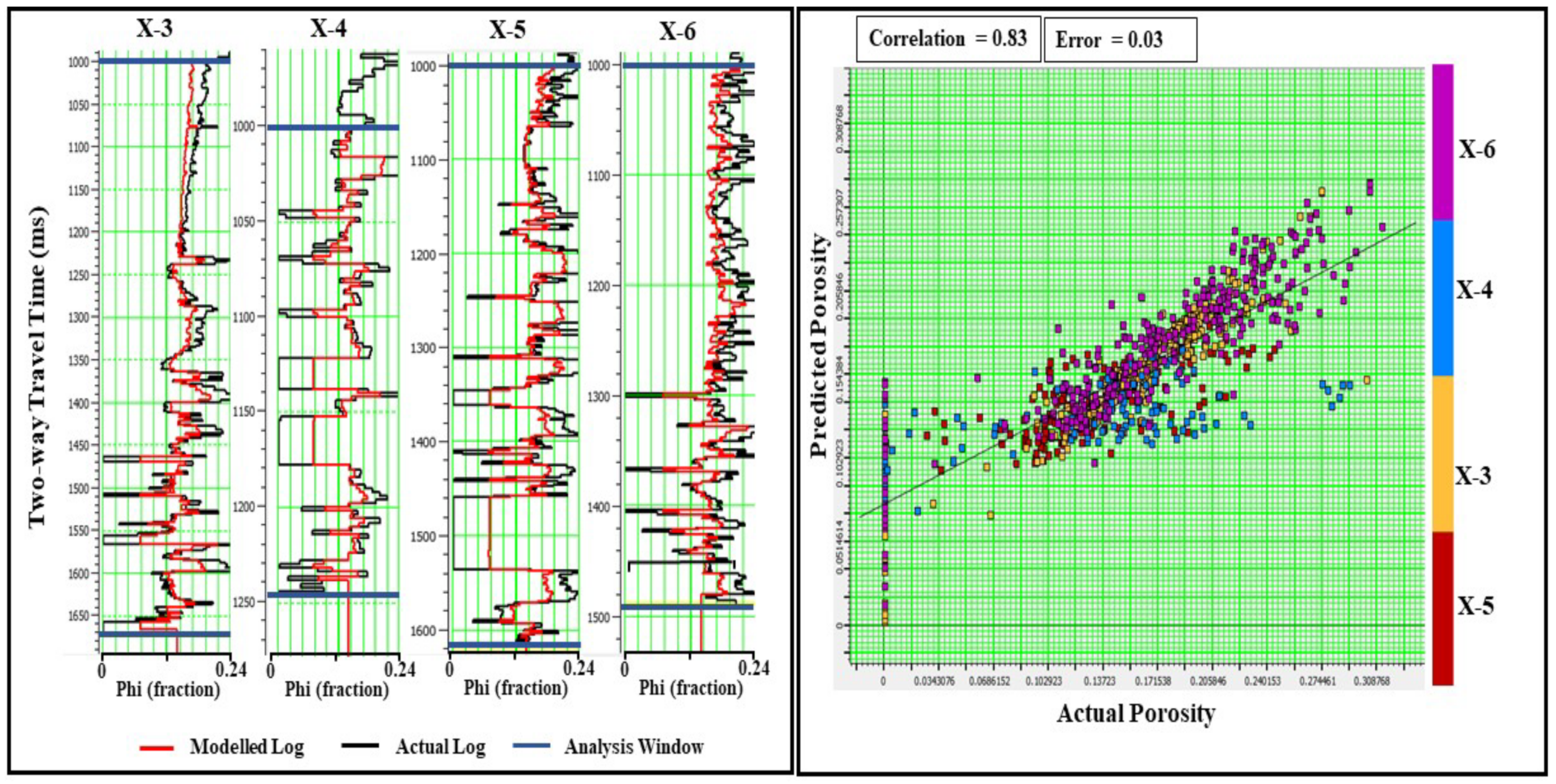

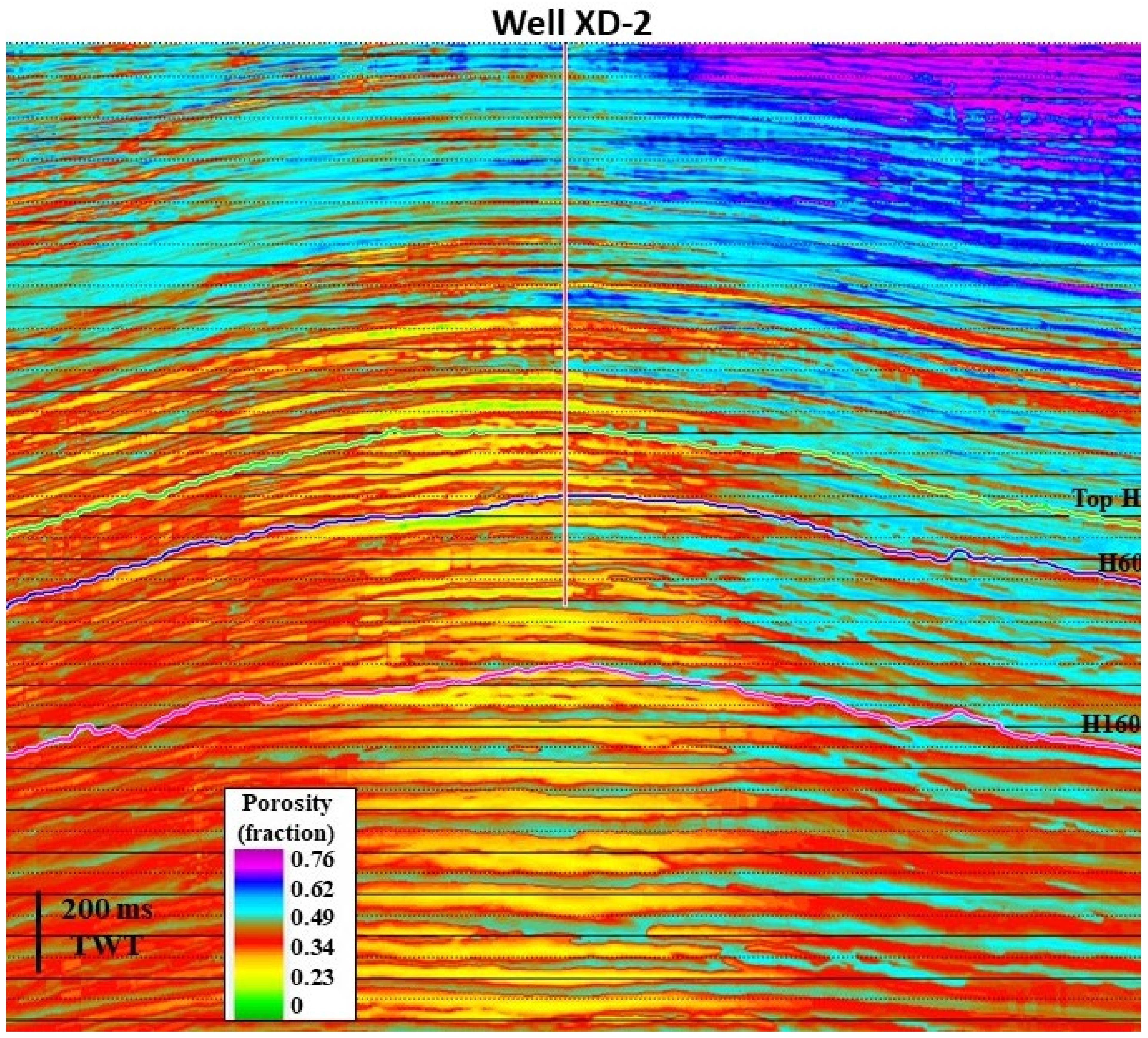
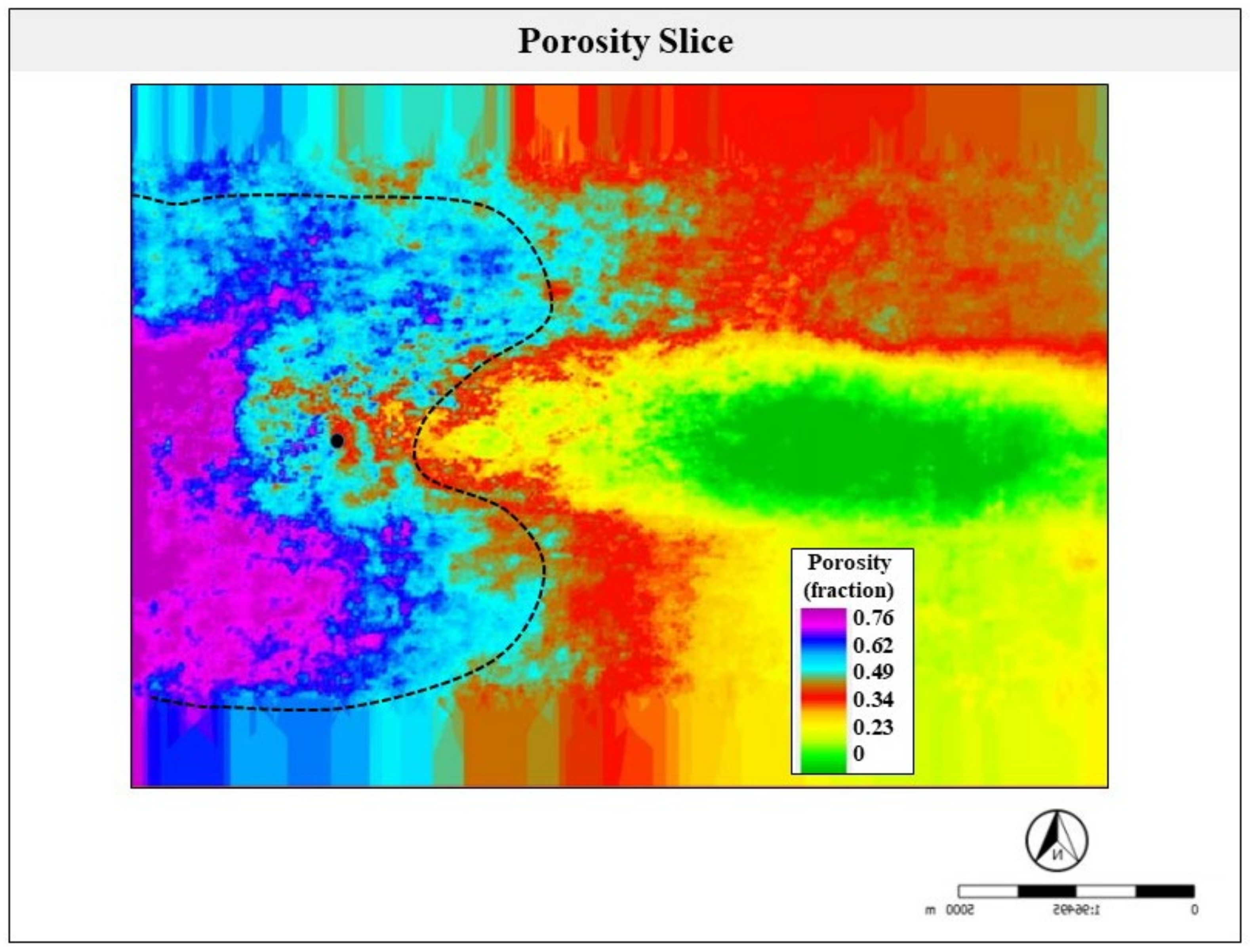
Publisher’s Note: MDPI stays neutral with regard to jurisdictional claims in published maps and institutional affiliations. |
© 2021 by the authors. Licensee MDPI, Basel, Switzerland. This article is an open access article distributed under the terms and conditions of the Creative Commons Attribution (CC BY) license (https://creativecommons.org/licenses/by/4.0/).
Share and Cite
Yazmyradova, G.; Hassan, N.N.A.A.N.M.; Salleh, N.F.; Hermana, M.; Soleimani, H. Reservoir Characterisation of High-Pressure, High-Temperature Zone of Malay Basin Using Seismic Inversion and Artificial Neural Network Approach. Appl. Sci. 2021, 11, 10248. https://doi.org/10.3390/app112110248
Yazmyradova G, Hassan NNAANM, Salleh NF, Hermana M, Soleimani H. Reservoir Characterisation of High-Pressure, High-Temperature Zone of Malay Basin Using Seismic Inversion and Artificial Neural Network Approach. Applied Sciences. 2021; 11(21):10248. https://doi.org/10.3390/app112110248
Chicago/Turabian StyleYazmyradova, Gulbahar, Nik Nur Anis Amalina Nik Mohd Hassan, Nur Farhana Salleh, Maman Hermana, and Hassan Soleimani. 2021. "Reservoir Characterisation of High-Pressure, High-Temperature Zone of Malay Basin Using Seismic Inversion and Artificial Neural Network Approach" Applied Sciences 11, no. 21: 10248. https://doi.org/10.3390/app112110248
APA StyleYazmyradova, G., Hassan, N. N. A. A. N. M., Salleh, N. F., Hermana, M., & Soleimani, H. (2021). Reservoir Characterisation of High-Pressure, High-Temperature Zone of Malay Basin Using Seismic Inversion and Artificial Neural Network Approach. Applied Sciences, 11(21), 10248. https://doi.org/10.3390/app112110248





